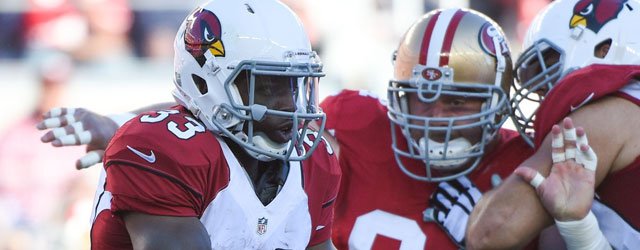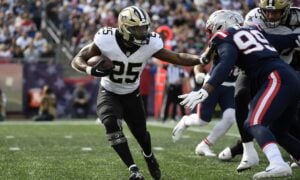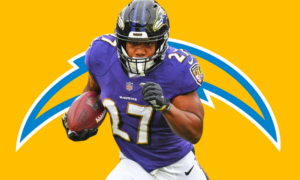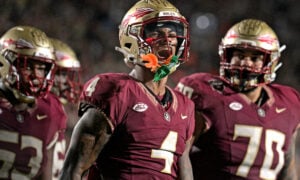Who is Kerwynn Williams?

After featuring wide receiver Jaron Brown (no relation) last week, we stick with the Arizona Cardinals and move into the backfield this week. Also just completing his second season in the league, Kerwynn Williams has taken a significantly different career path to potential fantasy relevance after being selected by Indianapolis in the seventh round of the 2013 NFL Draft.
When he entered college at Utah State (USU), Williams was predominantly a running back and wide receiver though he had experience at quarterback as well. It was at USU that he played solely as a running back on offense, though he was only used sparingly in his first three seasons due to the presence of running backs Robert Turbin and Michael Smith. Instead, he received significant time as the team’s primary kick returner beginning his freshman year.
After averaging more than 25 yards per return in 2009, best among first-year players, he increased his production to 27.2 yards per attempt as a sophomore. That season, he also began working his way into the offense with 81 carries and twelve receptions for a combined 561 yards and four touchdowns. As a junior the following season, Williams again received 81 carries but improved his yards per carry to 6.7 with three touchdowns.
[am4show have=’g1;’ guest_error=’sub_message’ user_error=’sub_message’ ]
Once Turbin (Seahawks) and Smith (Buccaneers) left for the NFL, it was Williams’ show and he did not disappoint. He received 218 carries and turned them into 1,512 yards (6.9 yards per carry) with twenty total touchdowns. He also had 45 receptions for 697 yards and five touchdowns. In all, he was just 72 yards shy of 7,000 all-purpose yards for his career, setting a school record for return yards and averaging 6.6 yards per carry on offense.
After graduating in December 2012, Williams focused on preparing for the NFL Combine. He placed third among running backs with a 4.48-second 40-yard dash, fifth in the 20-yard shuttle with 4.15 seconds and tied for seventh with a 35-inch vertical jump. Despite only one season as a starter, a strong performance at the combine coupled with incredible statistics in his final year propelled him into the third day of the draft.
After being selected by Indianapolis, Williams turned 41 preseason carries into 169 yards in addition to three receptions for six yards. Though he made the final cuts for the 53-man roster, he was waived just before the season and signed to the practice squad. When Vick Ballard suffered a season-ending injury twelve days later, he was promoted to the roster, but was released again ten days later. In early October, San Diego signed him to their practice squad, where he stayed for nearly a full calendar year before being released just before the beginning of the 2014 season.
Arizona signed him on September 18, though he didn’t get a carry until he rushed 19 times for 100 yards on December 7. He proceeded to lead the Cardinals’ backfield, which was without Andre Ellington, through the final three games of the season and their wild-card playoff loss to Carolina. Though he averaged an unspectacular 4.26 yards per carry in those games, he was the clear leader in carries over Marion Grice and Stepfan Taylor, particularly in week 17 and the playoff game.
Williams, at 5’8” and about 200 pounds, has a short and compact build. Though he has been used sparingly in the role, he is a good pass-catcher out of the backfield in addition to running between the tackles. As evidenced by his combine results, he has good speed, is very athletic and has the talent to make people miss when in open space. He also is versatile with proven production as a receiver and kickoff returner.
As is the case for any player in the NFL listed at 5’8”, a big concern is Williams’ size. His ability to hold up as a feature back is a common question, especially given that he did not have an opportunity to prove himself for an extended time in college. Pass protection and ability to find new lanes when the designated path is closed are also weaknesses that could limit the number of snaps he receives.
Given his strengths and weaknesses, it is clear Williams could be productive in the NFL in 2015 and beyond, but likely in a limited role as part of a committee. With Ellington’s return from injury, and the potential for the Cardinals to bring in additional running backs in the offseason, Williams faces more opposition for a job next year than he has over the last few weeks.
The uphill battle for Williams starts with the fact that the only current running back on the roster who will be a free agent this offseason is Zach Bauman. Ellington and Taylor have rookie contracts through 2016, who along with fullback Robert Hughes are all signed for $585,000 in 2015. Grice, who was also signed off San Diego’s practice squad, matches Williams’ contract of $510,000 for 2015 before becoming a free agent. The Cardinals already have four inexpensive running backs signed for 2015, and though Williams was given preference to close out the season, there are no guarantees for next season.
Williams definitely has some talent, but has already bounced around three originations despite being in the league for less than two years, and immediately slides to number two on the depth chart. If Arizona wants to keep him in the mix, with a healthy Ellington (not necessarily a guarantee) around Williams would need to become more of a between-the-tackles back, which would likely be difficult for an extended period of time given his size.
Consequently, while Williams had a couple solid performances at the end of the season, there is a lot of risk in investing in him from a dynasty perspective. He may eventually settle into a third-down role and catch a few more passes, as well as serve as a kick returner to boost his value on a 53-man roster, but I would not look to acquire him with the hope that he can propel recent opportunity into a full-time gig.
[/am4show]
- Dynasty Capsule: Jacksonville Jaguars - February 5, 2018
- My Beginner’s Guide to Reality Sports Online - May 12, 2017
- The DLF Mailbag - February 24, 2017


































































